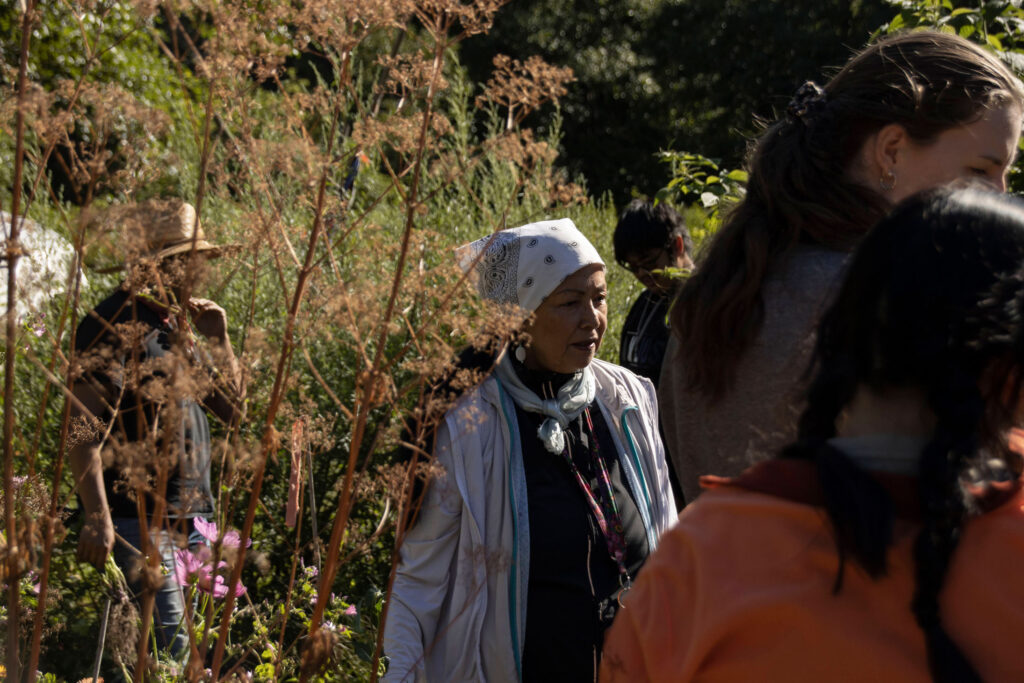
What happens if we shift our attention to focus on one small relationship? What happens when we choose to “tend” instead of “maintain”? How might this shift of intention and attention transform a community? Or a design practise?
Tending/attending, a landscape architecture elective led by Dr. Erin Despard, was a hands-on, experiential course combining philosophy, discussion, an individual tending of a project of our choice, and hands-on work in a variety of community gardens.
We worked in four gardens over the course of six weeks: Copley Community Orchard, Norquay Food Forest, the Means of Production Garden, and xʷc̓ic̓əsəm Garden at the UBC Farm. At each garden, we donned gloves and weeded, pruned, planted, harvested, spread mulch and tended the plants in the garden. We worked side by side, talking, sharing stories and knowledge, supporting each other. We learned to recognize different plants and understand what stories they tell us about soil.

We noticed how their form changes depending on location. We learned about their gifts, such as how a nuisance weed in one garden is a source of dye in another. We moved around different landscapes, noticing how the shape and form of each place created different opportunities for different bodies. Each garden was the nexus of overlapping communities.
For example, the community of the Means of Production (MoP) Garden echoes out in different circles. It is not a closed environment, with gardeners on the inside and everyone else on the outside. It is porous and multi-layered, bringing together the quiet stewards who pick up garbage in the morning; the gardeners and caretakers who nurture the soil and plants; the frequent visitors who occupy and use the space; the ants, beetles, mosquitoes and other bugaboos; the people who make art, and a multitude of living beings that find refuge, food, shelter and community under the canopy of branches. There are those who are actively involved in the tending of the space who have built implicit and explicit knowledge about the garden, and others who rely and benefit from this knowledge.
As part of our coursework, we were asked to tend something and to design something new based on our experience. Our projects ranged from experiments in growing mushrooms, fermentation, moss, plants, and mending clothes. Many of us discovered the fragility of our projects – we each had things that didn’t work the way we expected. We each adapted in different ways. Many of us deepened relationships with our friends and family members as we turned to them for support and advice or shared the outcomes of our experiments. Caring for one small thing, even if we do it alone, seemed to result in closer relationships with the people around us, hinting at the transformative power of caring and tending.
When we reflected on our experience tending, our work in the gardens, and our conversation with the stewards and volunteers at each garden, it became clear how important time was. In a tending paradigm, knowledge is acquired slowly over multiple seasons. We began to question how we, as future designers, could incorporate the insights of tending into the design process. Some of our observations included:
-Incorporating reflective observation: using a multi-sensory approach to observe and to take time to reflect on our observations.
-Being open to solutions that are untried: experimenting with novel solutions that are context specific.
-Know who or what we are tending: focussing on our primary relationship helps set priorities in times of conflict.
-Appreciating and valuing what is: we miss beautiful and wonderful opportunities if we focus on what “should” be.
-Give and take responsiveness: the needs of what we care for and our own needs and capacities change over time.
-Sticking with a material reality: working with what is there, even when that is hard or troublesome.
-Embracing difference and constructive conflict: it is in the tensions between different sets of needs and values that interesting ideas and solutions emerge.
-Unexpected wonder: take a moment to notice the extraordinary, and experience delight.

Dr. Alannah Young guides the students through the xʷc̓ic̓əsəm Garden at the UBC Farm
Our last gardening evening was in xʷc̓ic̓əsəm at the UBC Farm where we were hosted by Dr. Eduardo Jovel and Dr. Alannah Young. The experience was an extraordinary capstone to our course. We began the evening gathered around the sacred fire, perched on logs, and sheltered from the sun by canvas stretched overhead.
We were invited to introduce ourselves, not only to our hosts, but also to the land and the plants we would soon be tending. We took time to smudge. The smell of the smoke combined with the movements of my hands removed the day to day stresses and worries, carrying them into the sky. Smudging reminded me of other ceremonies, other times of sharing. This ceremony helped anchor me to the present and brought a sense of peace that is often absent in the day to day.
I am so often rushed, worried about getting something done. Even as I write out a blog post, I am worrying about the next assignment, the next chore. In smudging and making introductions, I was reminded to be present and focus on what is in front of me: the soil, the plants, the seeds, my classmates, my teachers, my hosts. By slowing down and being intentional at the start, I had more time. I could focus. I could be more open, more aware, and more connected.
That evening we weeded, planted seeds, harvested garlic and tied the bulbs into bundles. And at the end, we toured the garden, learning from our hosts. We tasted plants and flowers as we went. We experienced delight as we shared our new-found riches with each other. I had a sense of fullness. Not only from the richness of the garden, but also from my relationships with others, and the abundance of time. It is this sense of peace and community I hope to nurture in my design practice.
Laureen Stokes
3rd Year, MArch